AP Human Final
1/148
Earn XP
Description and Tags
Has all multiple choice qs and fill in the blanks from the AP Human Geography tests 1-6
Name | Mastery | Learn | Test | Matching | Spaced |
|---|
No study sessions yet.
149 Terms
A geographer's spatial analysis would entail
examining relationships and patterns across the physical distance between two objects.
confining the analysis to political boundaries.
restrictive examination of government control of territory.
examining only physical characteristics of the globe.
observing conditions only from a planetary and universal scale.
examining relationships and patterns across the physical distance between two objects.
Which of the following is NOT true?
Scale is the relationship between a portion of the earth being studied and the whole earth.
Space refers to the physical gap between two objects.
Place is a specific point on earth distinguished by specific qualities.
Space and place are the same thing.
Scale may be represented by a city block, a neighborhood, a city, boundary or an entire metropolitan area.
Space and place are the same thing.
Dating back to approximately 6000 BCE, we can judge that
fairly accurate navigational maps could only be produced after the start of the Industrial Revolution.
the first "true" maps appeared because of modern printing presses in the twentieth century.
sailors during the European Renaissance had paper maps that were far more useful to them than were the "stick charts" possessed by Polvnesian sailors and fishers.
maps have appeared in many forms in different societies and times, including modern paper maps, GPS in cars, and the urban maps of ancient Turkey.
maps that distort the sizes of Greenland and Antarctica are generally the best, although they make Africa and South America appear too small while simultaneously expanding the size of Europe.
maps have appeared in many forms in different societies and times, including modern paper maps, GPS in cars, and the urban maps of ancient Turkey.
Scale is
the system used by geographers to transfer locations from a globe to a map.
the spread of a phenomenon over a given area.
the difference in elevation between two points in an area.
the relationship between the length of an object on a map and that feature on the landscape.
the ratio of the largest to smallest areas on a map.
the relationship between the length of an object on a map and that feature on the landscape.
A map projection may distort a continent, making it appear stretched in some areas and smashed in others in order to
distort the shapes of other continents.
distort the distances and relative sizes of countries and continents.
depict a map that accurately represents a globe in every detail.
depict accurately the physical area of a country or continent.
depict accurately the shape of that same continent.
depict accurately the physical area of a country or continent.
The coordinates 150 E longitude, 89 N latitude are
near both the International Date Line and the North Pole.
near the equator but quite far from the prime meridian.
near the International Date Line and the equator.
near the North Pole and the prime meridian.
near both the Tropic of Cancer and the International Date Line.
near both the International Date Line and the North Pole.
The name of a location on Earth's surface is a
scale name.
site.
situation.
toponym.
geonym.
toponym.
New York City's ___ is approximately 100 miles northeast of Philadelphia and 100 miles southwest of Boston
location
site
situation
toponym
jurisdiction
situation
A geographer would be primarily interested in determining or locating a suitable _____ if he were wishing to study a remote, rural valley in Australia where bauxite is mined.
geocache
situation
site
toponym
Jurisdiction
site
Given your understanding of regions, the nine regions that the Census Bureau has established within the United States are examples of
governmental regions.
functional regions.
nodal regions.
formal regions.
vernacular regions.
formal regions.
Which of the following best describes the idea of a cultural landscape?
a landscape that has been completely modified, like a city center
a landscape set aside for historical preservation, like a Civil War
battlefieldland that has been developed with museums, concert halls, and
schools a landscape where human activity has modified the natural environment in some way
a landscape untouched by human activity, featuring mountains, rivers, and plants
a landscape where human activity has modified the natural environment in some way
The concept that the distribution of one phenomenon is related to the location of other phenomena is
geographic analysis.
spatial analysis
spatial association.
spatial distribution.
regional association.
spatial association.
When geographers say that the South is partly defined as a region by the Baptist Church, they understand that
low educational attainment and economic factors are not as
important as religion in determining the boundaries and/ characteristics of this region.the Presbyterian, Roman Catholic, Methodist, and other churches also attract adherents in the South, but to a lesser extent than do Baptist churches.
the Presbyterian, Roman Catholic, Methodist, and other churches attract almost no adherents because the Baptist Church has obtained such a high amount of power and state support there.
the Presbyterian, Baptist, Roman Catholic, Methodist, and other churches are supported by the state governments of the South.
Christian legislators in state governments do not let religious convictions and related biases interfere with their work.
the Presbyterian, Roman Catholic, Methodist, and other churches also attract adherents in the South, but to a lesser extent than do Baptist churches.
Which of the following are fundamental elements of culture?
customary beliefs, volcanic mountain ranges, and river settlements
material beliefs, customary forms, physical norms, and material social traits
social forms, material traits, customary beliefs, and physical environments
customary beliefs, material traits, and social forms
physical environments and material traits
customary beliefs, material traits, and social forms
To geographers, the spread of Starbucks around the world represents
economic proliferation.
a unique taste in nearly every location.
the relocation diffusion of restaurants.
economic globalization but not cultural globalization.
economic and cultural globalization.
economic and cultural globalization.
Spatial organization by ethnicity, gender and sexual orientation are examples of cultural
nodes.
identity.
toponyms.
geotagging.
meridians.
identity.
Among the elements of globalization of culture are tendencies toward
uniform consumption preferences, enhanced communications, unequal access to resources, and uniformity in cultural forms.
enhanced communications, heterogeneity, and equal access to resources
uniform consumption preferences, slower communications, unequal access to resources, greater access to entertainment, and a mixture of uniformity and variety in cultural forms.
maintaining local traditions.
maintaining local traditions along with uniformity of cultural beliefs
and forms.
uniform consumption preferences, enhanced communications, unequal access to resources, and uniformity in cultural forms.
The U.S. Land Ordinance of 1785 divided much of the country into a system of
townships, towns, cities, municipalities, and major urban centers.
ranges, distances, scales, projections, and map symbols.
town-county boundaries.
quarter sections, range sections, town land sections, and county sections.
townships, ranges, sections, and quarter sections.
townships, ranges, sections, and quarter sections.
The frequency of something within a given unit of area is
concentration.
density.
distribution.
pattern
dispersion.
density.
A ____ is the spread of something over a given study area.
concentration
density
distribution
pattern
diffusion
concentration
Global culture is often described as centered on three core cities, which are
New York City, Paris, Beijing.
Paris, Berlin, Tokyo.
New York City, London, Tokyo.
London, Los Angeles, Shanghai.
London, New York City, Shanghai.
New York City, London, Tokyo.
Which of the following are forms of expansion diffusion?
contagious and eponymous
hierarchical and formal
economic and relocation
contagious and hierarchical
relocation and stimulus
contagious and hierarchical
The diffusion of HIV/AIDS prevention methods and treatments in the United States is an example of which type of diffusion?
contagious
hierarchical
relocation
stimulus
geospatial
contagious
The difference in time it took for Columbus to cross the Atlantic and John Glenn to cross the Atlantic is an example of
better time measurement.
better geographic knowledge.
space-time compression.
establishing longitude as part of the grid.
establishing a prime meridian.
space-time compression.
The spread of Christianity in Africa suggests
hierarchical diffusion.
relocation diffusion followed by expansion diffusion.
expansion diffusion only.
stimulus diffusion.
contagious diffusion without relocation diffusion.
relocation diffusion followed by expansion diffusion.
Distortion is especially severe on
globes.
small-scale maps.
large-scale maps.
topographic maps
all maps.
small-scale maps.
The state of Hawaii is best considered a formal region because
only one language is spoken everywhere in the region.
the same state laws apply everywhere in the region.
the climate is the same everywhere in the region.
it is a part of the United States.
the same state laws apply everywhere in the region.
Globalization of the economy has
leveled economic differences between places.
heightened economic differences among places.
decreased investment in less developed countries.
drained resources from more developed countries.
decreased regional specialization of production.
heightened economic differences among places.
A hearth is
a region from which a phenomenon originates.
the process by which a feature or trend spreads.
an area defined by one or more distinctive features or trends.
the modification of a culture as a result of contact with a more
powerful one.perimeter of a regional feature.
a region from which a phenomenon originates.
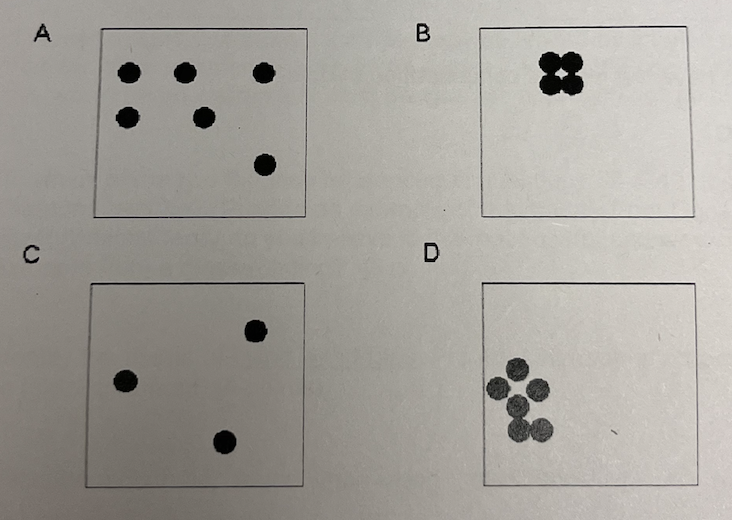
Which two of the four boxes has the highest density of dots?
A, B
B, C
C , D
A, D
A, D
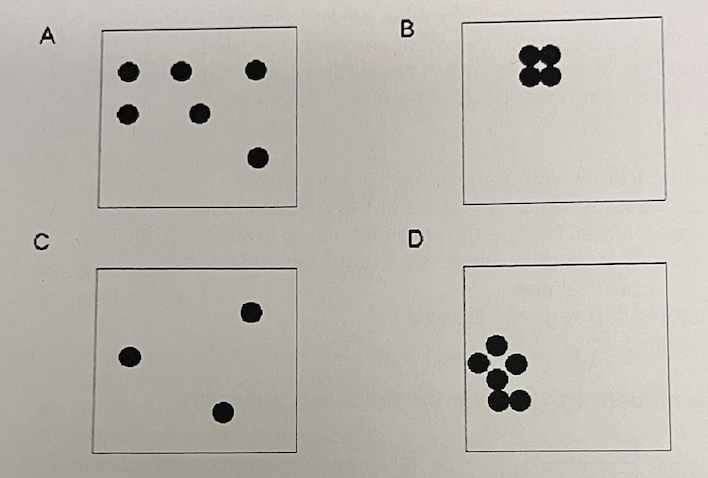
Which two have the highest concentration of dots?
A, C
B, D
A, B
C, D
B, D
Which of the following describes a concern for a country with an aging population?
As a country's population ages, the life expectancy for the younger population of the country decreases and healthcare costs decline.
As a country's population ages, the infant mortality rate decreases and there is an increased need for daycare centers.
As the proportion of older people in the country increases, fewer young workers are available to contribute tax revenues to support programs that provide services to the older population.
As the proportion of older people in the country increases, the sex ratio becomes disproportionally skewed toward males.
As the proportion of older people increases, the total population decreases because older people do not have children.
As the proportion of older people in the country increases, fewer young workers are available to contribute tax revenues to support programs that provide services to the older population.
In which of the following pairs do both countries exhibit zero or negative population growth rates?
Pakistan and China
India and Germany
Japan and Germany
China and India
India and Japan
Japan and Germany
Which factor is most responsible for the increase in Japan's dependency ratio?
An increase in life expectancy
An increase in the death rate
An increase in the rate of natural increase
A decrease in the doubling time
An increase in the total fertility rate
An increase in life expectancy
Sri Lanka and Australia have about the same population. What data would help you determine which country has a higher physiological population density?
The area of each country
The number of farmers in each country
The total fertility rate of each country
The amount of arid land in each country
The amount of arable land in each country
The amount of arable land in each country
The term that describes the concept that population will continue to grow even after fertility rates decline is known as
demographic momentum
demographic transition
rate of natural increase
the population pyramid
the homeostatic plateau
demographic momentum
Stages 1 and 4 of the Demographic Transition are similar in that
both have low growth rates.
both have high dependency ratios.
both have low life expectancies.
neither are presently observed
both have low growth rates.
Physiological population density is viewed as a superior measure of population density for which of the following reasons?
It is more reflective of population pressure on arable land.
It yields the average population density.
It is more reflective of the world's largest population concentrations.
It measures the average by dividing total land area by total number of people.
It best reflects the percentage of a country's population that is urbanized.
It is more reflective of population pressure on arable land.
Which of the following types of countries are most likely challenged with the problems associated with a large youth-dependent population, such as providing public primary education for all children?
More developed countries
Less developed countries
Free market countries
Landlocked countries
Island countries
Less developed countries
Which of the following explains why a country with a high physiological density (e.g., Japan, Egypt, or the Netherlands) risks exceeding its carrying capacity?
The population is clustered in key areas, so rural populations will not have easy access to public services such as schools and hospitals.
The population places a large amount of pressure on the arable land to produce enough food without risking severe environmental degradation.
The population is evenly dispersed throughout the country, so it is difficult to maintain infrastructure such as roads and telecommunication networks for the entire country.
There is a large number of people per unit of total land area, so there is no available land for farmers to raise crops and other food products.
The amount of farmers per unit of land area in these countries is too low to be able to support their populations.
The population places a large amount of pressure on the arable land to produce enough food without risking severe environmental degradation.
Relatively few people live at ____, but there are significant exceptions, especially in low latitudes.
low elevations
sea-level
high elevations
near coastlines
the poles
high elevations
The ____ provides a picture of society as a whole in a given year and the ____ seeks to predict the childbearing behavior of women
CBR; TFR
NIR; TFR
CBR; NIR
CDR; CBR
TFR; NIR
NIR; TFR
Zero population growth is best represented by a
TFR of 2.1 percent.
doubling rate of 2.1 percent.
CBR equal to the CDR.
negative NIR.
CDR greater than CBR.
TFR of 2.1 percent.
Approximately 500 babies were born in Country D in 2011, but 35 of them died before reaching their first birthday. These data can be used to report Country D's
crude death rate.
infant mortality rate.
early life expectancy.
murder rate.
terminal increase rate.
infant mortality rate.
Which of the following is the correct characterization of population density?
Arithmetic density is the best ratio to use when describing the "Why" of population density.
Physiologic density is the best ratio to use to describe human health.
Agricultural density ratios are the best representation of productive agriculture yields.
A comparison of physiologic densities and arithmetic densities helps geographers understand the capacity of land to yield food for the total population.
Arithmetic densities provide insight into relationships between resources and population centers in a particular region.
A comparison of physiologic densities and arithmetic densities helps geographers understand the capacity of land to yield food for the total population.
India and the United Kingdom have approximately the same arithmetic density although their landscapes and sizes are quite different. From this we can conclude that the two countries have roughly the same
level of output per farmer.
number of people per area of land
pressure placed by people on the land to produce food.
number of farmers per area of land.
number of people per area of arable land.
number of people per area of land
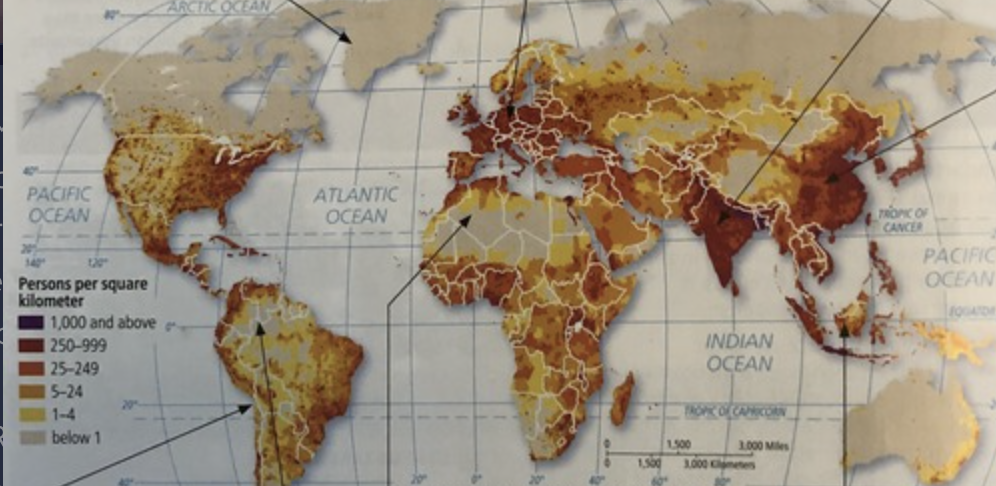
By analyzing the map above, which equatorial nation-state is the most populous?
Uganda
Indonesia
Ecuador
Mexico
India
Indonesia
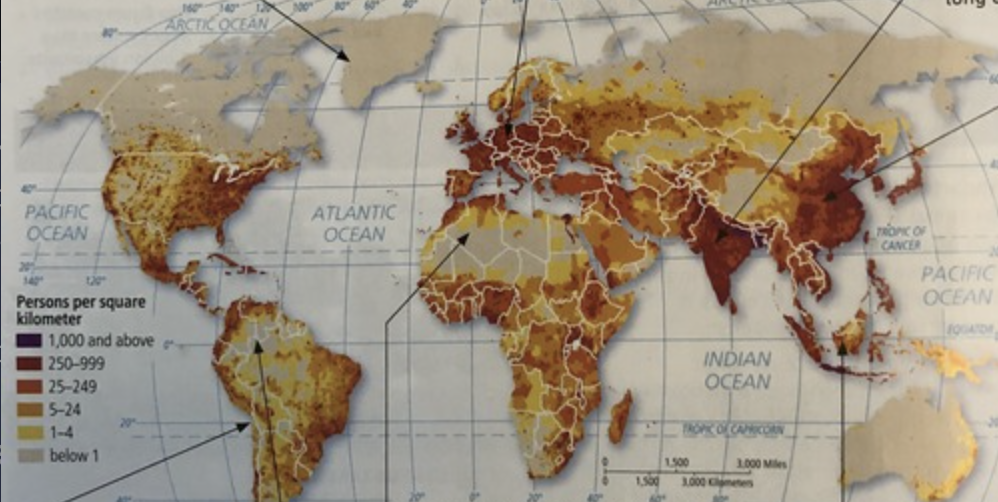
By examining the map above, which of the following is NOT true about the
world's population concentrations?
The highest European population concentrations exist around major rivers and natural resources as well as major urban centers.
China's population is evenly distributed across its land area.
South Asia's population is heavily concentrated around key rivers such as the Indus and Ganges.
Australia's concentrations are largely coastal.
Sparse population concentrations may be found north of 60 degrees latitude.
China's population is evenly distributed across its land area.
Europe and North America entered stage 2 of the demographic transition as a result of
the agricultural revolution.
the computer revolution.
the scientific revolution.
the industrial revolution.
the medical revolution.
the industrial revolution.
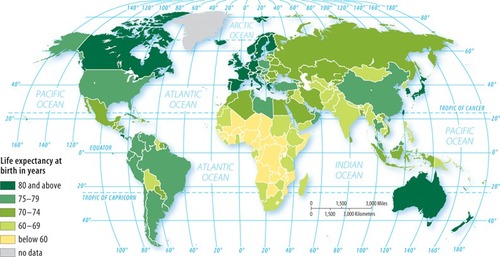
By analyzing the map above, which East Asian nation-state has the highest life expectancy?
China
Mongolia
Taiwan
North Korea
Japan
Japan
We can hypothesize with some confidence that Costa Rica has a lower crude death rate than the United States because Costa Rica
has a higher sex ratio.
has more hospitals per person.
has a milder climate.
is in Stage 4 of the demographic transition.
has a lower percentage of elderly people.
has a lower percentage of elderly people.
Africa, Asia, and Latin America entered stage 2 of the demographic transition as a result of
the industrial revolution.
the medical revolution.
the scientific revolution.
the agricultural revolution.
the computer revolution.
the medical revolution.
It may sound strange to hear that the ____ is generally lower for less developed countries than for more developed countries, but the difference is correlated to the average age of each population.
crude birth rate
crude death rate
infant mortality rate
natural increase rate
total growth rate
crude death rate
Country X has a crude birth rate of 40 and a crude death rate of 15. In what stage of the demographic transition is this country?
Stage 1
Stage 2
Stage 3
Stage 4
Stage 5
Stage 2
The standard biological ratio at birth of 105 males to 100 females is NOT found in which two countries?
the United States and Canada
Nigeria and Ethiopia
France and the United Kingdom
India and China
Australia and New Zealand
India and China
The shape of a country's population pyramid
may be used to predict maternal mortality rates.
cannot be used to determine infant mortality rates.
may be used to estimate the country's dependency rate.
cannot be used to estimate the country's sex ratio.
is determined primarily by the combination of its crude birth rate and its crude growth rate.
may be used to estimate the country's dependency rate.
A dependency ratio of 65 represents
that only those over 65 are dependent on government services.
that the population is a greying population.
that more women are expected to enter the labour force
that for every 100 people, 65 are dependent on the current labor force.
that for every 100 people, 35 are dependent on the current labor force.
that for every 100 people, 35 are dependent on the current labor force.
Leading approaches to reducing birth rates emphasize the long-term benefits of
teaching people to become more active consumers.
school programs that ignore contraceptive techniques and teach "abstinence only."
improving men's educational attainment in conjunction with small loans to businesses owned by men in small communities.
improving local economic conditions in conjunction with improving women's educational attainment.
information about sexually transmitted diseases.
improving local economic conditions in conjunction with improving women's educational attainment.
This stage of the epidemiological transition describes a reduced mortality associated with infectious diseases and an increase in chronic disorders associated with aging.
Stage 1
Stage 2
Stage 3
Stage 4
Stage 5
Stage 3
One important feature of the world's population with the most significant future implications is that
the natural increase rate is larger every year.
there are fewer people in the world now than at the peak in the middle of the twentieth century.
the most rapid growth is occurring in the less developed countries.
people are uniformly distributed across Earth.
the less developed countries have the highest combined crude death rate.
the most rapid growth is occurring in the less developed countries.
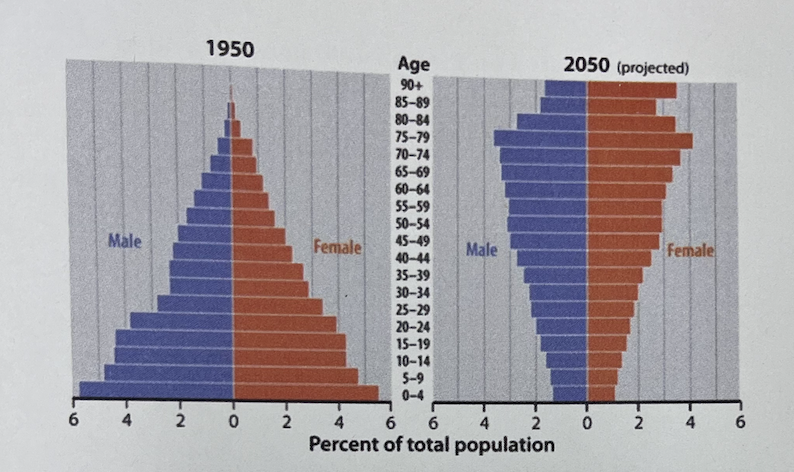
A population pyramid like Japan's predicted 2050 pyramid represents
the results of medical technology transfer seen in developing nations
a government policy to attract elderly immigrants.
an aging population and contraction in the work force.
a younger population decimated by the pandemic AIDS.
recovery after the 2011 earthquake.
an aging population and contraction in the work force.
The lowest crude birth rates are found in countries in which stage of the demographic transition
Stage 1
Stage 2
Stage 3
Stage 4
Stage 5
Stage 4
Wilbur Zelinsky's model of migration predicted
women are more likely to migrate than men.
long migration distances are more likely than short.
migration characteristics vary with the demographic transition.
intraregional migration is more important than interregional.
migrants move most frequently for economic reasons.
migration characteristics vary with the demographic transition.
Several million Irish migrated in the 1840s primarily because
the English forced them to become refugees.
disastrous economic conditions pushed them out of the country.
poor environmental conditions induced them to migrate.
they were attracted to the United States.
Spanish invasion threatened their homes.
disastrous economic conditions pushed them out of the country.
Many of the first Europeans to settle in Australia migrated to serve jail sentences which is the combination of which push and pull factors?
cultural push, economic pull
environmental push, cultural pull
economic push, cultural pull
economic push, environmental pull
environmental push, economic pull
economic push, cultural pull
Most migrants to the United States during the peak of the 1840s and 1850s came from which part of Europe?
Norway and England
Ireland and Germany
Italy and Poland
Spain and Portugal
Russia and Bulgaria
Ireland and Germany
U.S. quota laws from the 1920s until the 1960s had the effect of
virtually ending immigration.
indirectly causing two world wars.
dramatically increasing immigration from around the world.
ensuring the majority of migrants continued to be from Europe.
increasing the possibility of migration from regions previously prohibited.
ensuring the majority of migrants continued to be from Europe.
Most Asians are currently migrating to the United States through the process of
expansion diffusion.
brain drain.
chain migration.
illegal immigration.
global relocation.
chain migration.
Recent immigrants to the United States
are nearly evenly distributed among all states.
are distributed evenly along the southern U.S. border and the east and west coasts.
are concentrated in Texas, California, and Illinois and are seldom in other areas.
have not been attracted to rural and agricultural areas.
are spread throughout several states according to economic prospects.
are spread throughout several states according to economic prospects.
The Brazilian government encouraged interregional migration by
making Rio de Janeiro and Sao Paulo more attractive.
dictating optimal locations for factories.
clearing the rainforest for agricultural activities in the interior.
moving the capital to Brasilia.
industrial development on the Atlantic coast.
moving the capital to Brasilia.
The most prominent type of intraregional migration in the world is
north to south.
region to region.
urban to rural.
city to city.
rural to urban.
rural to urban.
Suburbanization of more developed countries is due to
expanding urban territory.
increasing employment opportunities.
desire to change lifestyle.
regional development.
global investment.
desire to change lifestyle.
The largest level of interregional migration in the United States was caused by the
arrival of Europeans beginning in the 1600s.
illegal immigration from Latin America.
immigration of Asians beginning in the early twentieth century.
opening up of the western territories.
industrial development in the northeast.
opening up of the western territories.
Counterurbanization is
the move from urban core to suburban areas.
due to expanding suburbs.
migration to rural areas and small towns.
the trend of the elderly retiring to rural locations.
decline of the inner-city infrastructure.
the move from urban core to suburban areas.
In the United States, which is likely to cause virtually all population growth in the next few decades?
natural increase rate
net in-migration
crude birth rate
declining death rate
urban expansions
net in-migration
In contrast to popular culture, folk cultures are more likely to vary from
place to place at a given time.
from time to time at a given place.
both from place to place and from time to time.
neither from place to place nor from time to time.
with rapid change.
place to place at a given time.
Folk cultures are spread primarily by
contagious diffusion.
hierarchical diffusion.
relocation diffusion.
stimulus diffusion.
epidemic diffusion.
relocation diffusion.
Popular culture
is transmitted from one location to another through small scale and local migration.
diffuses through relocation diffusion.
typically follows the process of hierarchical diffusion from nodes of innovation.
is usually transmitted orally across time and location.
typically follows the process of hierarchical diffusion from nodes of innovation.
In contrast to folk culture, popular culture is more likely to vary
from place to place at a given time.
from time to time at a given place.
both from place to place and from time to time.
neither from place to place nor from time to time.
from time to time at a given place.
Terroir refers to
a group's sense of place.
a group's food taboos.
the relationship between the physical environment and culture.
the sum of the effects of the local environment on a food item.
the sum of the effects of the local environment on a food item.
Pioneer farmers settling the grasslands of the American West often built houses of sod, while early settlers of the eastern forest built wooden structures like log cabins. This suggests that building materials
are strongly influenced by local resources.
are commonly imported over long distances because of local folk culture.
are chosen because of the diffusion of popular culture.
are a uniform feature of folk culture.
are elements of popular culture.
are strongly influenced by local resources.
Diffusion of Internet service is following the earlier pattern of television, EXCEPT
the United States share of world use is expanding.
diffusion is much faster.
diffusion is much slower.
expansion of service is faster in Africa than Asia.
initial use was in less developed countries.
diffusion is much faster.
The global diffusion of popular culture may threaten folk culture by
being less responsive to the diversity of local environments.
the integration of popular culture into local customs.
threatening local environments through the diffusion of information by technology.
serving as a catalyst for the advancement of folk culture.
being less responsive to the diversity of local environments.
The diffusion pattern of Walmart stores, which have spread from small towns to large cities throughout the United States, is an example of
relocation diffusion
contagious diffusion
stimulus diffusion
distance decay
reverse hierarchical diffusion
reverse hierarchical diffusion
Which of the following best accounts for the universal appeal of blue jeans?
Diffusion of popular culture
Adoption of unique folk culture
Impact of high income on clothing habits
Lack of barriers in communist countries
Need for durable clothing
Diffusion of popular culture
A group that gives up its cultural traditions such as food and clothing preferences and adopts that of the dominant culture has undergone the process of cultural
agglomeration.
assimilation.
denial.
shift.
citizenship.
assimilation.
In contrast to folk culture, popular culture is typical of
large heterogeneous groups
indigenous groups
groups that have little interaction with other groups
small homogeneous groups
groups living in isolated areas
large heterogeneous groups
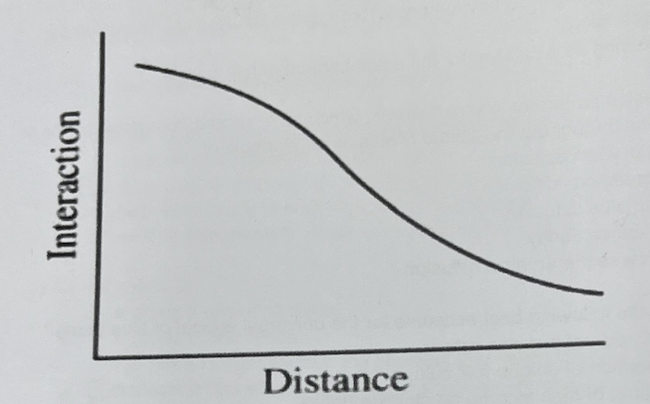
According to the figure below, which of the following choices best describes the changes in interaction as distance increases?
It remains unchanged.
It increases at first and then decreases.
It increases.
It changes randomly.
It decreases.
It decreases.
Transnational migrants often send money back to their home countries to support non-migrant family members. What is the term used to describe their international financial transactions?
Reparations
Quotas
Foreign aid
Foreign direct investment
Remittances
Remittances
The main effect of modern communications on social customs has been to
preserve folk cultures by increasing awareness of their uniqueness.
stimulate the diffusion of folk cultures around the world.
increase the similarity of social customs in different locations.
have little effect on the diffusion of social customs.
slow the rate of change.
increase the similarity of social customs in different locations.
The geographic study of the distribution of languages provides a good example of
the interplay between globalization and local diversity.
the diffusion of folk culture in different areas of the world.
the role and spread of religion across much of the world.
political conflicts that arise due to ethnic tensions.
the interplay between globalization and local diversity.
A literary tradition is
a form of a language used for official government business.
a form of a language spoken in a particular area.
a collection of languages related to each other.
the written form of a language.
the variety of dialects in a language.
the written form of a language.
An institutional language
describes Latin as the basis for much of the English vocabulary.
describes the language of the leading spiritual groups.
describes the language used in education, work and mass media.
describes the language of the medical profession.
describes the language used in meetings at the United
Nations.
describes the language used in education, work and mass media.
English has achieved unprecedented acceptance globally due to
the role of colonialism and imperialism.
its role as the common language of a global economy and culture.
the rise of popular culture and the decline of folk culture.
the diffusion of religion from MDCs to LDCs.
its role as the common language of a global economy and culture.
The main difference between languages in the same family, branch, or group is how
recently in time the languages were once the same.
closely the speakers of each language live to each other.
similar the cultures of the speakers of each language are.
all of these
recently in time the languages were once the same.
A creolized language is
extinct.
a mix of indigenous and colonial languages.
an isolated language family.
a possible prehistoric superfamily.
a revived formerly extinct language.
a mix of indigenous and colonial languages.
Both the Angles and the Normans contributed to the development of the English language, because they
spoke Germanic languages.
invaded England.
spoke languages derived from Latin.
diffused English around the world.
agreed to divide England.
invaded England.
The language spoken by soldiers stationed throughout the Roman
Empire was known as
a dialect of Latin.
a Romance language.
a standard language.
Vulgar Latin.
Catalan.
Vulgar Latin.
Urdu is the most important language of
Bangladesh.
India.
Iran.
Pakistan.
Sri Lanka.
Pakistan.
The Icelandic language has changed less than any other Germanic language because of
Iceland's close contact with other people and activities.
migration by German tribes.
Iceland's relative isolation from other places.
the extinction of the East Germanic group.
continuous exchange with Norway and Sweden.
Iceland's relative isolation from other places.